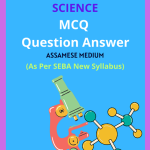Class 7 Science MCQ Chapter 4 Heat Solutions in English Medium, Class 7 Science Multiple Choice Question Answer in English to each chapter is provided in the list so that you can easily browse throughout different chapters Class 7 Science MCQ Chapter 4 Heat Notes and select need one.
Class 7 Science MCQ Chapter 4 Heat
Also, you can read the SCERT book online in these sections Class 7 Science Objective Type Solutions by Expert Teachers as per SCERT (CBSE) Book guidelines. These solutions are part of SCERT All Subject Solutions. Here we have given Assam Class 7 Science MCQs Solutions in English for All Subject, You can practice these here.
Heat
Chapter – 4
| MCQ |
1. The degree of hotness or coldness of a body is called:
(a) Heat.
(b) Light.
(c) Temperature.
(d) Energy.
Ans: (c) Temperature.
2. Which of the following is a reliable measure of the degree of hotness of an object?
(a) Our sense of touch.
(b) Colour of the object.
(c) Temperature.
(d) Size of the object.
Ans: (c) Temperature.
3. Which of these is a conductor of heat?
(a) Wool.
(b) Paper.
(c) Copper.
(d) Wood.
Ans: (c) Copper.
4. What is the range of a clinical thermometer?
(a) 0°C to 100°C.
(b) -10°C to 110°C.
(c) 35°C to 42°C.
(d) 37°C to 45°C.
Ans: (c) 35°C to 42°C.
5. Which device is used to measure body temperature?
(a) Laboratory thermometer.
(b) Barometer.
(c) Clinical thermometer.
(d) Hygrometer.
Ans: (c) Clinical thermometer.
6. Which of these is an insulator?
(a) Copper.
(b) Wood.
(c) Iron.
(d) Silver.
Ans: (b) Wood.
7. What is the normal temperature of the human body?
(a) 36°C.
(b) 37°C.
(c) 38°C.
(d) 39°C.
Ans: (b) 37°C.
8. Heat from the sun reaches us due to:
(a) Conduction.
(b) Convection.
(c) Radiation.
(d) Vibration.
Ans: (c) Radiation.
9. In which of the following materials is heat primarily transferred by conduction?
(a) Solids.
(b) Liquids.
(c) Gases.
(d) Vacuum.
Ans: (a) Solids.
10. Conduction, convection and radiation are:
(a) processes through which heat transfers
(b) scales of temperature
(c) different forms of energy
(d) types of thermometer
Ans: (a) Processes through which heat transfers.
11. Which of the following materials is an insulator?
(a) Copper.
(b) Wool.
(c) Aluminium.
(d) Iron.
Ans: (b) Wool.
12. The normal temperature of human body is:
(a) 37 K
(b) 37°C
(c) 37°F
(d) All of the above
Ans: (b) 37°C.
13. Why do we feel more comfortable in light-coloured clothes during summer?
(a) They are more stylish.
(b) They absorb more heat.
(c) They absorb less radiation.
(d) They are made of lighter material.
Ans: (c) They absorb less radiation.
14. How does wool keep us warm in winter?
(a) It is a good conductor of heat.
(b) It traps air between the fibres.
(c) It allows heat to pass through easily.
(d) It reflects heat away from the body.
Ans: (b) It traps air between the fibres.
15. Solids transfer heat by:
(a) Conduction
(b) Convection
(c) Radiation
(d) All of the above
Ans: (a) Conduction.

Hi! my Name is Parimal Roy. I have completed my Bachelor’s degree in Philosophy (B.A.) from Silapathar General College. Currently, I am working as an HR Manager at Dev Library. It is a website that provides study materials for students from Class 3 to 12, including SCERT and NCERT notes. It also offers resources for BA, B.Com, B.Sc, and Computer Science, along with postgraduate notes. Besides study materials, the website has novels, eBooks, health and finance articles, biographies, quotes, and more.



